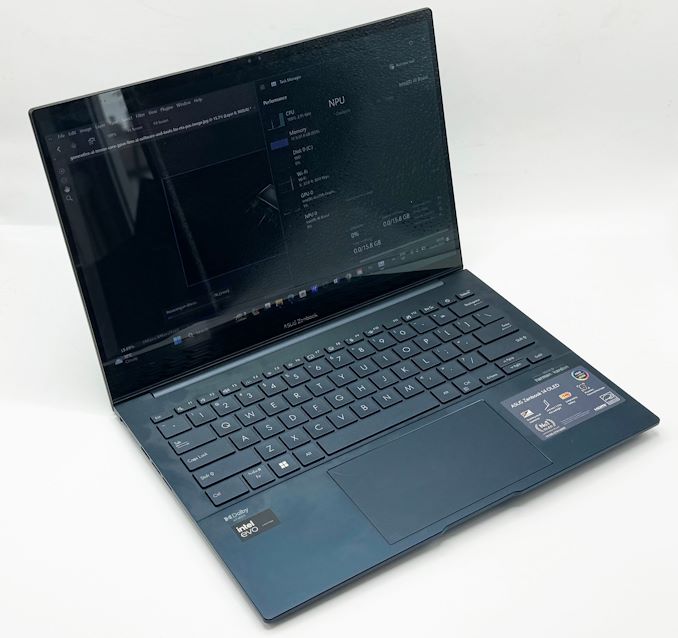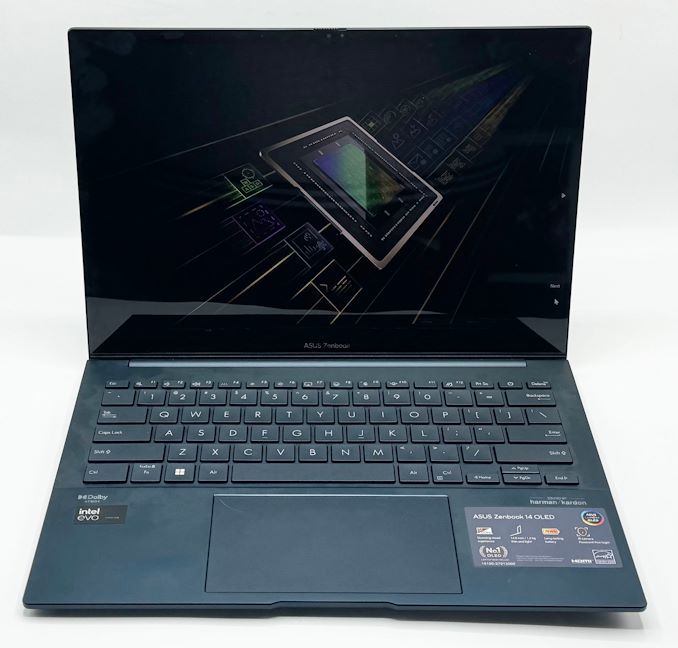The Intel Core Ultra 7 155H Review: Meteor Lake Marks A Fresh Start To Mobile CPUs
by Gavin Bonshor on April 11, 2024 8:30 AM ESTASUS Zenbook 14 OLED UX3405MA: Closer Look
The ASUS Zenbook 14 OLED is one of Intel's EVO-certified notebooks, offering plenty of style and substance within the thin 14.9 mm chassis. While ASUS hasn't provided information on what the chassis is built from, it does look and feel like an aluminum chassis, which doesn't feel particularly cheap and looks the part. As with the rest of the chassis on the ASUS Zenbook 14 OLED, the lid is made from the same aluminium-like material, and it looks very stylish with the Ponder Blue color.
At 312.4 x 220.1 x 14.99 mm (W x D x H), it's portable. The inclusion of the 14-inch 2.8K OLED display and a total weight of just 1.28 kg (2.82 lbs) makes it very capable for its size, as well as a very lightweight offering to travel with. For comparison, the Apple MacBook Air 13-inch (M3) weighs just 0.04 kg less.
Opening up the traditional clamshell design, we can see the 14-inch OLED panel dominating the top half, with the keyboard and the centrally located island-style trackpad. The trackpad doesn't have any discrete buttons, and instead is entirely touch-based. The keyboard keys themselves have a shallow key press and combine the cursor arrows with the (Fn) key functionality while offering a subtle white backlight behind the keyboard, making the Zenbook 14 OLED 'pop.' Although ASUS doesn't include a dedicated fingerprint scanner, along the top of the panel's bezel is a 1080p webcam with a privacy shutter with support for Windows Hello, which can be configured to provide IR face recognition without needing a PIN.
Touching on the display, with a 2.8 K (2800 x 1800) OLED panel, it's fair to say that with the brightness turned up, it's very vibrant and colorful, to say the least. The 14-inch display, according to the official specifications, has a peak brightness of 500 nits when using HDR, while it has a 400 nits peak brightness when HDR is turned off. It can cover 100% of the DCI-P3 color gamut, with a 0.2 ms response time. Regarding refresh rate, the panel supports 120 Hz, while ASUS allows users to switch between either 60 Hz or 120 Hz operation. The panel also has a capacitive touch layer, and ASUS includes a stylus within the packaging for this model.
Looking at the I/O on the ASUS Zenbook 14 OLED, ports and connectors are on both sides of the chassis. Focusing on the left side, it offers a single USB 3.2 G1 Type-A port towards the fold. Three ports look like connectors, but these are just ventilation gaps for airflow to escape.
On the right side are two Thunderbolt 4-capable USB Type-C ports, which support external displays and offer USB power delivery (USB-PD) capabilities. The Zenbook 14 OLED doesn't have a dedicated connector for charging, and instead relies on carging through its USB Type-C ports, with ASUS including a 65 W AC Type-C charger in the box. Also on the right-hand side is a single HDMI 2.1 video output and a single 3.5 mm combo audio jack. ASUS includes a USB Type-A to Ethernet adapter in the box, which I haven't seen for a while.
Overall, from looking at and considering the feel of the ASUS Zenbook 14 OLED UX3405MA, it's certainly a quaint premium 14-inch ultrabook. The bottom-mounted Harmon Kardon linear speakers, which don't look much, sound great and are certainly better than typical stock speakers. There's also the 14-inch OLED screen, which looks great and is vibrant and crystal clear, as expected from an OLED panel.
With a price tag (as configured) of $1299, the ASUS Zenbook 14 OLED UX3405MA is certainly a capable offering, which is powered by Intel's latest Core Ultra 7 155H Meteor Lake SoC, but style and design are one element; performance is perhaps the most important element.
ASUS Zenbook 14 OLED UX3405MA: Software
Before we examine the performance, we'll quickly examine the software bundle supplied. Everything on the ASUS Zenbook 14 OLED revolves around the MyASUS software, which acts as a centralized hub for functionality, profiles, updating drivers/software, and customization.
The MyASUS software has many different device settings that users can customize, such as enabling battery care mode, which limits battery charging beyond 80% immediately. Users can also select between three different fan profiles, including performance mode, which maximizes performance, although this does mean the notebook runs very loud. The other options include standard mode, which dynamically adjusts based on the temperatures, and whisper mode, which is very useful for watching moves in bed.
There are also many display-related options, including allocating more system memory to the integrated Arc Xe graphics and different visual profiles to select from depending on the task. Overall, there are plenty of functionalities within the MyASUS software hub, and having it all within a unified piece of software makes things much better for the overall user experience.


























69 Comments
View All Comments
mode_13h - Wednesday, April 17, 2024 - link
I wonder if the reason they did it that way is to do with how programs which explicitly set affinity typically do so. The rationale might be something like:1. Make single-threaded programs and the main thread of multi-threaded programs fast.
2. For multi-threaded programs, the next set of threads should be efficiency-optimized. Reply
Marlin1975 - Thursday, April 11, 2024 - link
So it uses more power and still loses in most things to the AMD chipwow, I thought intel was getting better and this is all they have? Let alone AMDs newer Zen5 chips are coming soon and will only move their lead further. Reply
Pheesh - Thursday, April 11, 2024 - link
well, it definitely isn't using more power, perhaps you skipped over the battery/power section? A lot less power during general office type usage, despite a thinner chassis that can deal with much less thermals etc. But the laptops being compared are so vastly different this whole review seems kinda....meaningless? The razer 14 is a 4lb gaming laptop, with thermals to boot, in a comparatively massive chassis. And it's being compared against a macbook air esque form factor. The reader isn't gaining much from a comparison to another processor that does not exist in a comparable form factor/power envelope. ReplyRyan Smith - Thursday, April 11, 2024 - link
Ultimately that's down to AMD and Intel. One sampled a 42W notebook for their mobile CPU launch, the other sampled a 28W notebook. We've equalized things as much as we can, but we can only test what we have (or in the case of the MSI, get our hands on). Replytipoo - Thursday, April 11, 2024 - link
M3 would be a great comparison point ReplyTheinsanegamerN - Thursday, April 11, 2024 - link
M3 is an entirely different arch, in a different OS ecosystem, with its own special API. You're comparing apples and giraffes. Replymode_13h - Monday, April 15, 2024 - link
For those apps which run on both machines, it's absolutely a valid comparison. If all the apps you need are supported on both, then it's useful to see how they compare because you really could pick either one. Replymode_13h - Monday, April 15, 2024 - link
Toms' review includes M3, however they only have a few benchmarks. It's not as comprehensive a review as this one.https://www.tomshardware.com/laptops/ultrabooks-ul... Reply
clemsyn - Thursday, April 11, 2024 - link
Thanks for the review. Looks like Intel is waking up and going the right direction. I just hope its not too late (which I think it is). Replymeacupla - Thursday, April 11, 2024 - link
135H has 8 Xe cores, not 7 Reply